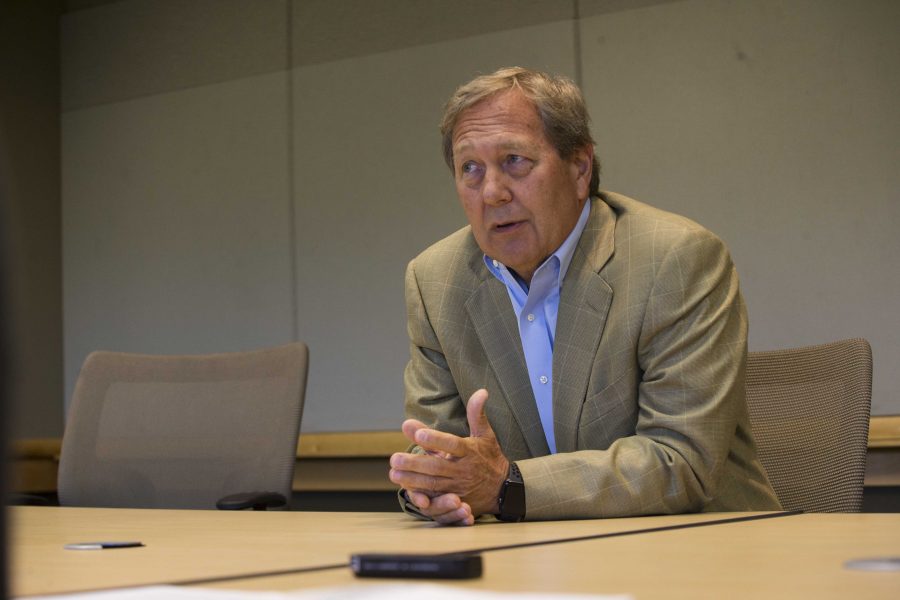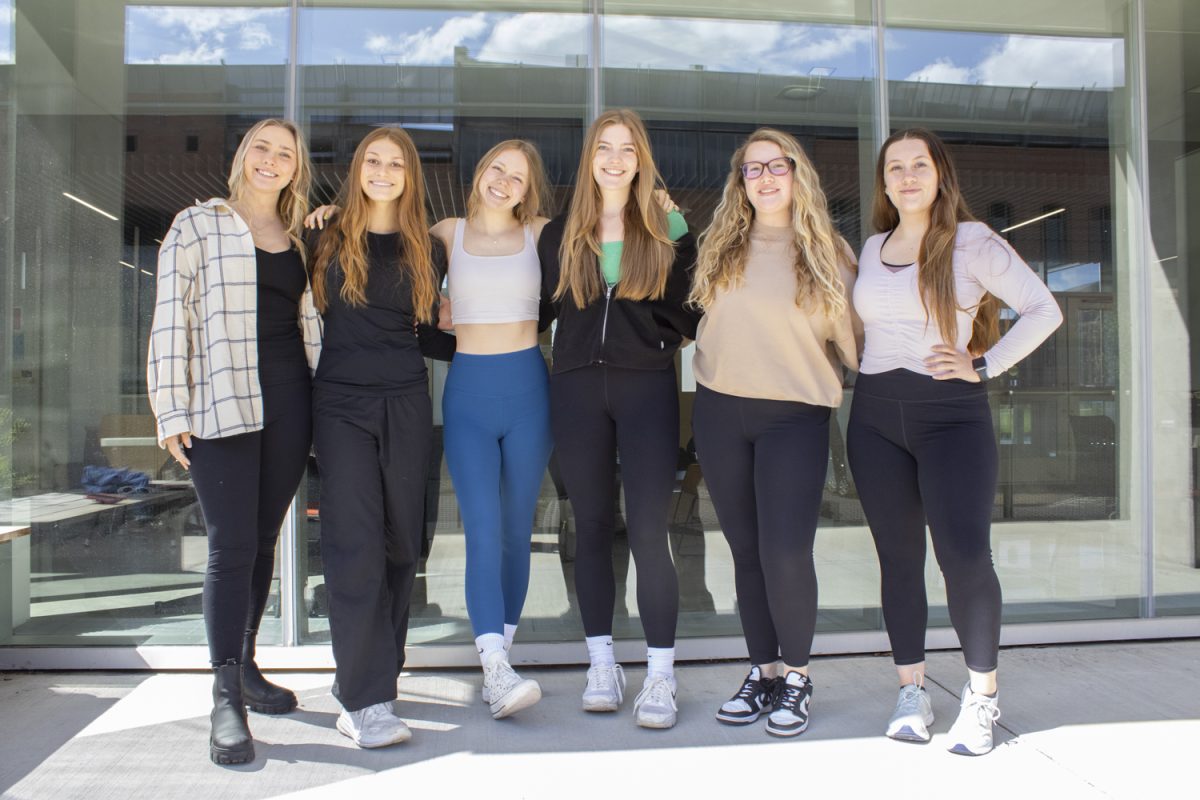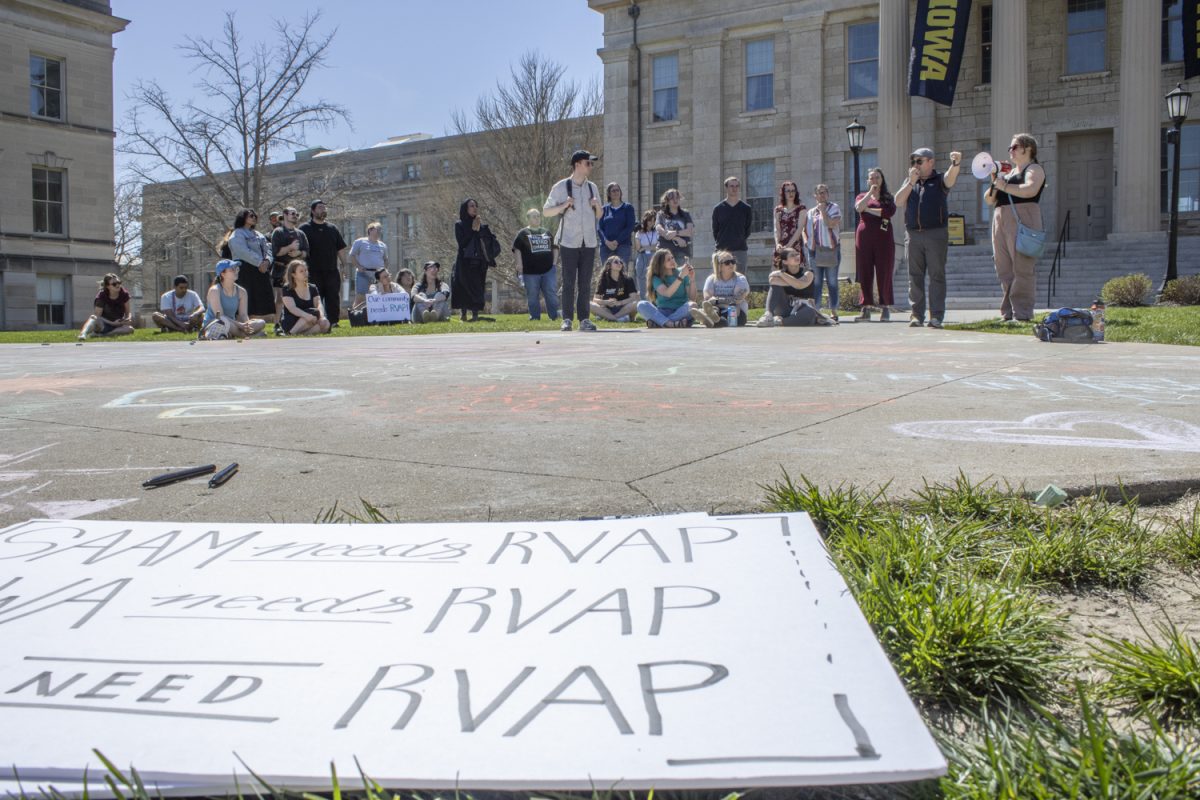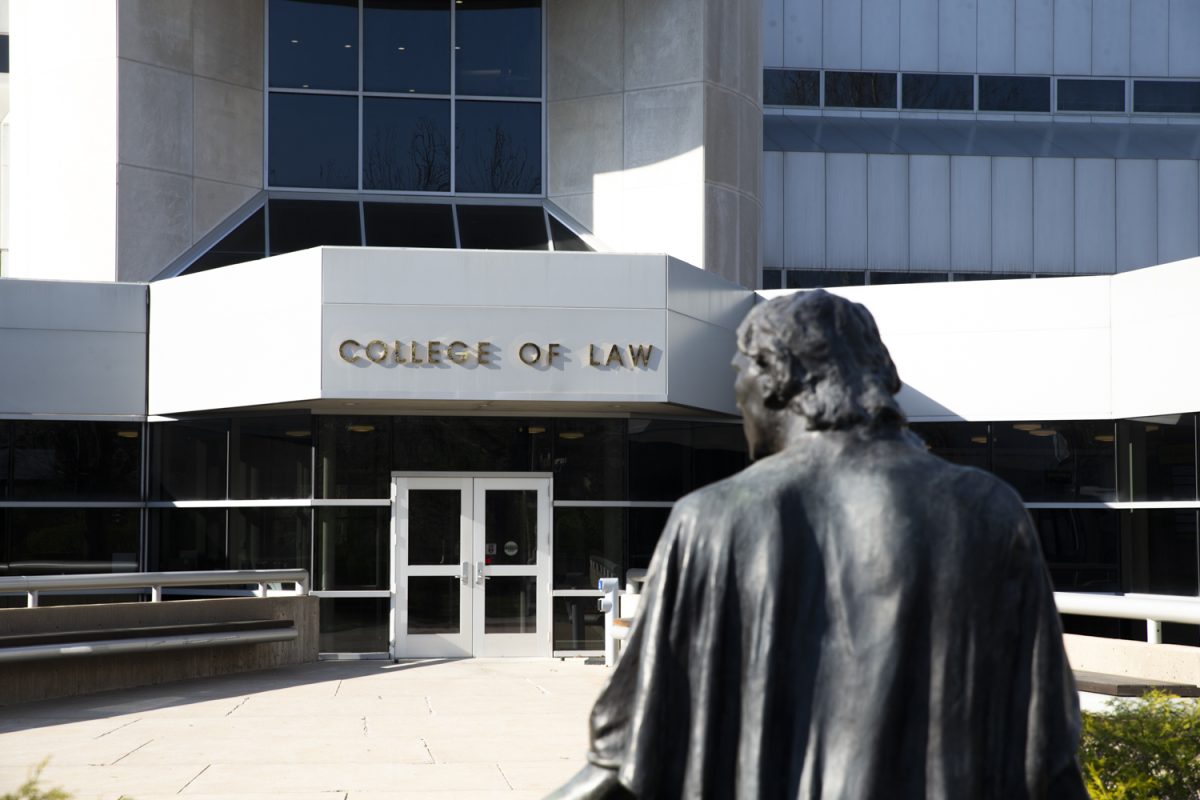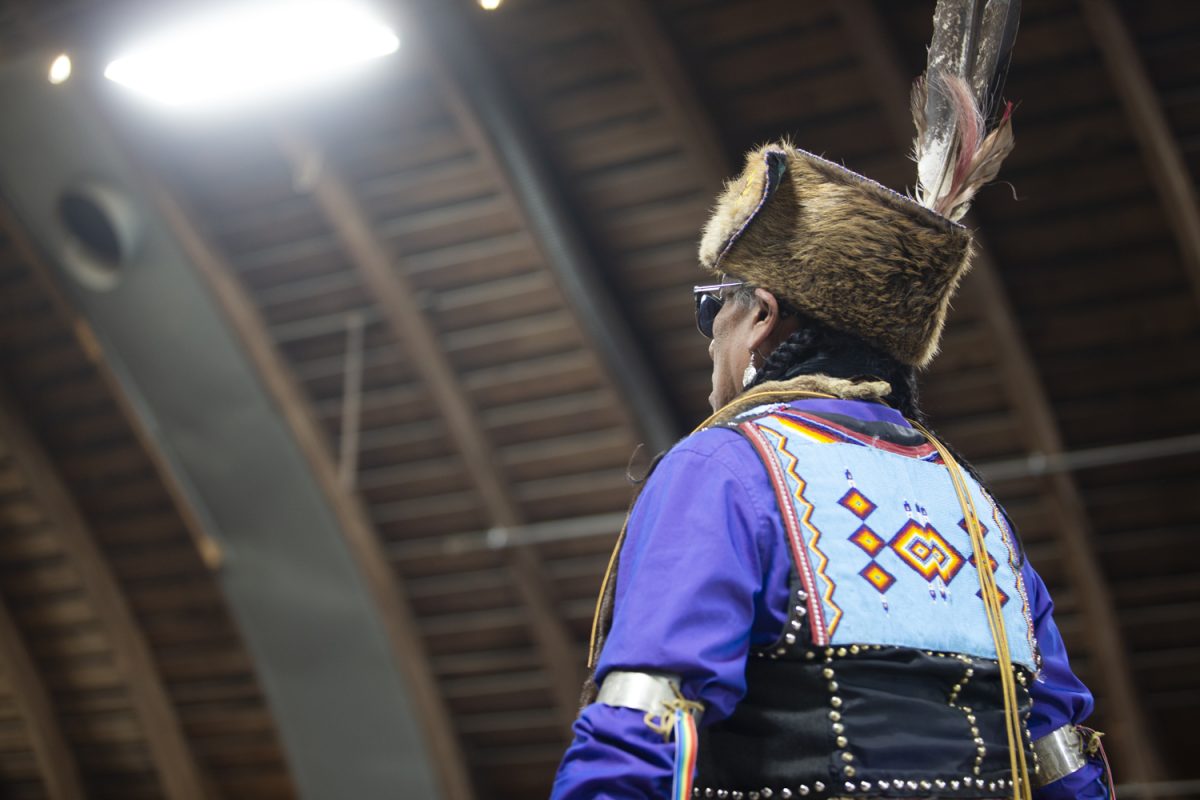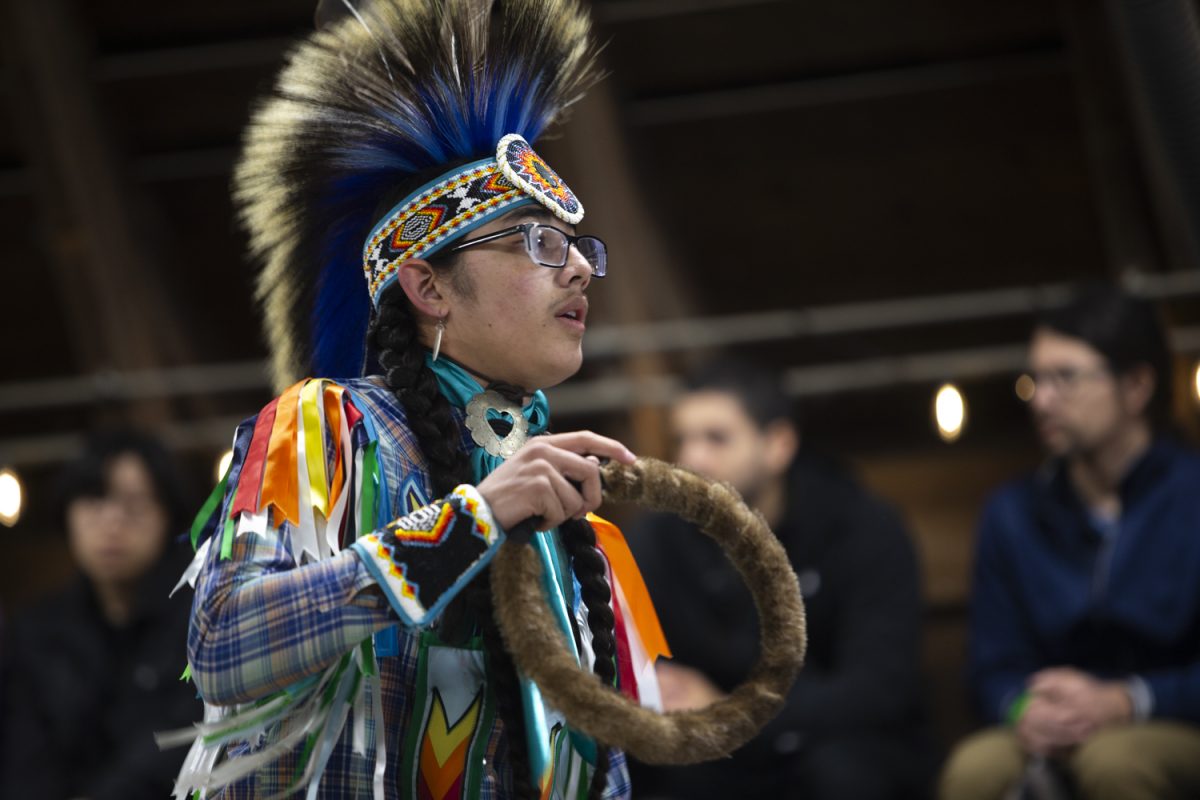DI: You’re coming into your second full year as president of the University of Iowa. How would you say you’ve taken the UI from “great to greater,” as you said you wanted to in 2015. What still needs to be done to make the UI “greater”?
Harreld: I think it’s definitely a work in progress. I think one of the things I’m really proud of is we’re actually having the right discussions. I think we’ve embraced the reality of what’s happened over the last decade in terms of academic performance, support systems for undergraduate and graduate students, and we see that we have some opportunities. The big issue in front of us right now — which I’m sure we’ll get to — is the issue of fiscal support and how we improve in a number of really critical areas, so it’s still a work in progress, but I’m really pleased. The community is embracing the reality of where we are and having serious, frank conversations about how to improve.
DI: You’ve spoken to us before in the past about the travel ban and how that might affect University of Iowa students and what the UI would do in response to that. With the announcement this morning about Trump administration’s intent to end the DACA program, what do you see happening and what programs might students who might be affected be getting?
Harreld: I understand the comparison to the travel bans, because there were really two, and in that particular case we could specifically identify members of the community who were impacted by the two different travel bans. This is a little bit different in the sense that we don’t have any data as to who or how many are impacted. It also will impact us, I think, in different ways. It won’t impact us at all in admissions, because we don’t use any of that data or information in the admissions process. On the other hand, clearly there are members of our community that could well be impacted by this, and so part of what we’re trying to do is just get out word to anybody who is individually or family or friends may be impacted and let us know, and we have a lot of different support systems here on campus. We actually have a Hawkeye DREAMers team that’s prepared to do anything necessary to help those impacted. I think the second thing to make pretty clear is — which I’ve done and we’ve done over the last year — is we don’t think this is a good thing to do. I’ve expressed my concern directly to the administration through various letters; I think there will be another one going out, because I haven’t read the details of what happened this morning. I sense there is a suspension for a period of time, in a sense trying to get the Congress to deal with it, so I suspect we’ll be writing a letter to the leaders in Congress outlining where we stand on this. So it’s a little different from what happened with the travel ban, so anybody who has any specific needs: come see us; we’re here to help.
DI: The UI announced the decision to close the Tippie full-time MBA program recently. Alumni have expressed concerns about the logic that led to that programs closure, potentially leading to the closure of other programs. Is there any potential that could happen? Are there any concerns on the university’s behalf about the loss of the cultural value of the program and what that means?
Harreld: We aren’t the only ones. I used to actually teach in that kind of full time MBA program at another institution, and i think many institutions are taking a look at the shift in what we’ll call the channel of how one gets an MBA. Its fascinating to me at this point in time our MBA enrollment total is over 1100 students and its at an all time high, but what’s happening is more and more students are trying to get their MBA while also working. And so they’re looking for nighttimes, weekends, cohorts coming together for several months, and then going back to work. So the channels are changing, is what I call it. The full time MBA, Wake Forest and several other institutions have also closed theirs down. It’s been more demand related, so demand has shifted, to other MBA programs, were finding the need to do the same thing, and we actually think we can take the resources thats been going to the full time MBA, put it up against the other programs that are increasing in demand, and do a better job there. We have no plans currently to shift anything else out of MBA but I will say we are continually looking at every channel for all degrees trying to make sure they make sense and they close economically particularly during this difficult fiscal period, and I’m sure we’ll talk about tuition and resources and all the rest here in a minute; it would be imprudent if we weren’t asking these kinds of questions.
I don’t think we did the Tippie MBA closure for fiscal reasons, it was really a shift in the demand. On the other hand, now that we’ve decided it, we can repurpose that money to places where there’s higher demand. I think if we didn’t do these sort of things people would be critical of us for not using our money expeditiously.
DI: With the regents’ Tuition Task Force meetings this summer, it’s opened up questions about the value of a University of Iowa degree and that in relation to higher-education funding. What would you say right now is the value of a University of Iowa degree, and if this plan were to be implemented, what do you envision that value being in 2022?
Harreld: Give me a moment, because I think this is a pretty important question, I think it’s nuanced, and I’m finding that we don’t like nuanced, complicated issues in today’s society, but some of them are, and I think this is one of them.
I’m pretty concerned that the way in which we’re talking about it is devolving into, ‘7 percent tuition increase in five years.’ Let’s back all the way up. To your point about the value, people who came to us a decade ago have seen during this past decade that in US News, World Report, AAU, or other ranking systems the value of that brand drop pretty significantly, and I’m concerned that that will continue unless we do some things differently. And that’s where this all begins.
We have a choice about what quality we want, how our brand stacks up against other brands. How our graduation rates in four years or six years, or the salaries five years or 10 years out stack up relative to other institutions. And this process begins for me with a hard look at our peers. We benchmark against several Big Ten institutions, not all the Big Ten, plus we add in North Carolina, Arizona, Texas, and UCLA; that’s our peer group. Any way we look at the data, we’ve fallen in the last decade. Then we asked ourselves, ‘How will we regain?’ That’s the basis of the strategic plan that was approved last year about this time. And if you poke underneath that, you’ll see that the needs fall into three big buckets. One is student outcomes: how we improve the graduation rates, the application rates to graduate school or to jobs, etc. The next bucket is research, and the third bucket is engagement with the state. In all three areas, we have identified very specific activities that we are not doing enough in. We now have a clear idea on how to improve, if we were given the resources and permission to go ahead. If not, then I think it’s a choice, but the consequences will be more of the same, and that’s what really concerns me, because it would continue diminish of the value and I think that’s not good enough.
I will also say what’s happened over the last three or four years on purpose, we’ve continued to shift our student body toward more first-generation students. We had I think 20 percent three years ago, two years ago 23 percent, and I think when the data comes here in the next few days, I think the current class is going to be 24 or 25 first-generation students. I think we all know if we’re going to continue that — and I think we should — it requires support for the individual students, and that’s expensive, and we can do better than we currently are. That then gets us into a plan that we benchmark relative to our other institutions — what they do in these areas — and we see a gap of about $150-165 million, not per year — over that five year period. And we say, ‘Okay, where does that money come from? Where would it come from?’ I think simply put, it could come from three areas. One is by remixing expenses, and how we currently use monies that are being used on campus. We’ve looked at — and this is one piece that frustrates me, because I stood up a couple weeks ago and said $11 to 12 million every year — in other words, $55 to 60 million from remixing our own expenses to go against these three areas that we’ve identified strategically. That’s 35 percent of it. So remixing and using as few dollars as possible outside the strategically critical areas. That will pick up about 35 percent of it. The next two then become tuition or state appropriations. And we’ve immediately jumped into saying the state won’t give us any money, which would then require a 7 percent increase in tuition over the next five years, but that’s a choice too, because the state could actually pick up — remember how I said 150 and 165, and a third of that will come from internal remixing — so let’s just say the balance is $100 million. If the state gave us $20 million more per year each year, the state could pay for it with zero tuition. And so now there’s sort of an iso line on a graph, if you have tuition over here and you have state appropriations over here, one point is zero percent tuition increases for the next five years, and 20 million from the state. Another place is a 7 percent increase, and nothing from the state, and there’s everything in between. I’m finding that Iowans are jumping over the discussion of what quality of institution we should have. They’re jumping over the remixing of expenses that we are trying to put up against this. Iowans are jumping over the state Legislature’s ability to help finance this, and just jumping completely into 7 percent and saying it’s too much. Well, there’s a lot of other things along the path there, and I think we should discuss them all.
And if we don’t get that, then there will be consequences, just as in the last 10 years, benchmarked against these other institutions, we’ve fallen. I’m nervous; I’m not going to lead an institution going towards mediocrity. We are better than that. We know it; we know how to do it. I want to have that dialogue. Give us a chance.
DI: Students have already expressed concerns about the current tuition rate preventing them from finding their next meal and things like that regardless of the discussion of additional increases. I recognize that some of the money gained would go toward certain student populations through financial aid, but not everyone will have access to that aid. We’re at the point where students are being priced out of a University of Iowa education. So what are the University of Iowa’s priorities: to be affordable and accessible or is it to be competitive with these peer institutions?
Harreld: Well, I don’t want to answer a question by asking a question, but embedded in what you said, where do you think we stand as Iowans relative to household income in the other states that are in our peer group — Illinois? Minnesota? Arizona? California? I mean, so there’s an impression that somehow we are worse-off than people in those other states. Our household income is third from the top. North Carolina has the lowest household income. … The second implication is where is our tuition today? You say is it pricing out — well, after five years of 7 percent increases, we will still not be the average of our peer group. Think about that — five years of 7 percent a year compounded, we will still be less than the average of our peer group, in terms of tuition. So I understand it’s hard; I understand we don’t like it. But right now, we’re at the rock bottom, and we’re at the rock bottom also in state appropriations. Just to give you an interesting discussion point, the University of North Carolina, which has a household income much lower than Iowa — it’s a bigger state, but in terms of averages, their household income is lower. They get $248 million a year more. We get $216 [million] a year from the state of Iowa. They get $248 million more, okay, with a student body of 28,000. We have a student body of 33,000. And they get $18 million more year per year through tuition than we do. I just don’t think we’re pricing ourselves as much out of the market as you might have been suggesting in your question. I think we’ll do just fine. We had over 30,000 applications this year, and if we ended up with 28,000, I think we can still get a student body of 5,000, 5,100. I don’t think we’re pricing ourselves as much out of the market.
Now, I think you’re raising a couple of very important points. One is that we also will need to take up student financial aid. And we are committed — part of this discussion is about the gross tuition level. None of you pay gross tuition. On average, our tuitions are 30 percent lower than the gross tuition. I don’t know if any of you know this, but the tuition was 29.6 last time I looked at it. So everyone here is getting almost 30 percent, on average. Secondly, as we take tuition up, we’re also going to have to take that up to support students who will need it. So … anybody who has a fiscal problem should come see us. There are a lot of different mechanisms. Some of them will be eligible for merit scholarships. Some of them will be eligible for our own fiscal, need-based scholarships. And loans, some of them federal. There’s a whole set of tools we have; I don’t think we’re going to price anyone out.
Then what I’ll finally say is when I used to teach the MBA program, I said there are two ways to price yourself out of the market. One is you get your prices too high. We’re a long way from that; I already covered that. Secondly is that you get your prices so low, the quality goes so low that the market is expecting something you can’t deliver. We’re going towards that; I think we’re pricing ourselves out of the market on that downside, because we can’t offer the support systems. Particularly when we’ve gone from 20 to 23 to 25 percent first-generation students, and we doggone well know they need more support the first year, year and a half. If we know how to provide it, yet we can’t afford to provide it, that 25 may need to be moved back to 20, and that’s wrong; that’s not who we are, so we’re committed to that. If we could have more student dorms, more residence halls, we would, because it makes academics go up, campus safety goes up. We could probably pop two or three more Catletts up if we had the resources. Students would be better off; we’d have more support resources. I think we’re probably pricing ourselves out of the market on the downside. We got a lot of work to do, and I think we know how to do it.
DI: If we’re trying to remain competitive with these peer institutions and move our tuition to the median of those groups, why does the University of Iowa continue to use its low cost relative to those peer groups as a selling point to prospective students?
Harreld: Do we? Do we also use quality? Those two things go hand in hand. I don’t think our selling proposition is, ‘We’re just cheap.’ I think our selling proposition is, ‘We know how to be good, and we’re going to improve your lives long term,’ and that’s a balance. What we tend to do in these conversations is pull one element of that out and have a conversation about it. You need to understand that it all comes together. If you don’t like the peer group, let’s change the peer group. Let’s don’t be in the big leagues. Let’s don’t be up against Michigan and UCLA and Arizona. We can become pick your regional school and get benchmarked against a different set. That’s a choice — that’s back to where we started this whole conversation a few minutes ago. We have a set of choices: who do we want to be, who do we want to aspire to, and I think this institution has a long history of aspiring to be the best of the best. I think Iowans deserve an institution in their state where they can go at state tuition and be really, really world class. The question is how do we sustain that, and I don’t think it’s just that we say we’re cheap. If it’s really cheap that we’re after, there are wonderful institutions that are all over the place that are cheaper than we are still, and community colleges are cheaper. I think there’s something around the quality and the price, and that’s a dynamic I think we’ve lost perspective on.
DI: I’m sure you’re aware, but former UI Student Government President Rachel Zuckerman emailed the Tuition Task Force to advocate for the institutions to be transparent in their messaging about where tuition stands years down the line. What is your response to that?
Harreld: We put out a — she’s right; I agree with Rachel. I think transparency almost at any level helps us in a lot of different ways. But in particular situations, tuition, I think predictable tuition out over several years — these are really, really important issues. I talked to students, parents about tuition increases. What they’re really frustrated with is they get a surprise in the middle of the year that the state deappropriates us and then we have to put a tuition increase and it’s like, ‘Whoops.’ We need to get out of that mode. That was the attempt at putting together a five-year view of what this might look like, and I would really welcome the state to actually put out a five-year view of state appropriations and stick to it. That would then allow us to talk about the balance on tuition. We’ve put out a five-year view of how we’re going to take costs out and reposition them to meet the strategic plan. We’ve done the same thing with tuition. I think most of us are kind of worried about what the state will do, because right now they’re in a year-by-year sort of mode, and in the last several years, whatever we put forward, they’ve taken out. They took $16 million last year, and I think — I’d have to go back and check the numbers — but I think we took our tuition up about 12 or 13 or 14 — not 16, it was a little less, so they deappropriated us more than we took tuition up. That’s not us. This year-by-year process — so I’m committed to putting five-year plans in place on the tuition side, on the cost takeout side — but the big uncertainty is what the state’s going to do year by year. The state’s taken out from this institution about $200 million over the last 10 years or so, probably a similar amount or more at the other state institutions, [University of Northern Iowa and Iowa State University], so that’s to say that’s maybe $400 million or more. That’s a hard way to run these institutions and that’s a cost that’s shifted tuition. It’s got to get out of a year-by-year, knee-jerk reaction to something more predictable, so I agree with Rachel. The problem is we only control a piece of this. We control our internal costs, the regents control tuition, and the third hand clapping that needs to come together is the state. Those three are not right now on a consistent economic fiscal model for the long term, and the students are getting buffeted around by that. It’s not fair.
[Editor’s note: According to regents’ documents, the UI will generate $16.51 million in incremental revenue from the fiscal 2018 tuition rate increase. The state reduced appropriations by more than $15.4 million for fiscal 2017 and 2018.]
DI: What do you view your role to be in ensuring the state Legislature adequately funds the state institutions?
Harreld: Doing what we’re doing here — getting the message out, getting the complexity of it out, making sure that we understand the tradeoffs that we’re dealing with. I understand they have asked us to benchmark, so making sure they know where we are relative to those institutions, and then answering any questions they have at any time, including current politicians. I spend a fair amount of time with people running for office. Some may view that as political; I view that as part of our job, which is to help inform them what is going on, what the facts are to make sure they make better decisions. But at the end of the day, we are a republic; we are not a democracy. We elect as individuals the people who represent us in the state Legislature and in the executive branch in the state, and at the end of the day, the people decide based on who they elect who to vest with this power. My job is to help the people in those positions have all the facts that they could possibly need, and to make it very clear where I think the tradeoffs are. For example, if we don’t find ways through this discussion fiscally, well, we probably can look pretty clearly at the last decade in terms of outcomes and see that we’re not going to change what we do; it’s kind of likely we’re going to continue the path we’ve been on. I think that path is unacceptable. If you have a better idea of what I should do, let me know. I wish I could make the decisions, but I don’t.
DI: One area people have looked to as a potential solution for our funding situations is athletics contributing to academics. You’ve discussed that issue with the DI previously. In light of the announcement from Gary Barta that athletics is contributing several million to the university, can you expand on that and explain where that money was used last year, specifically, and what the money will fund this fiscal year?
Harreld: Gary and I started this conversation two years ago, and last year they contributed $2 million, as he said. This year it’s another $2 [million]. We’ve got plans for it to go up from there. What it’s specifically used for, I have left to the Athletics Department, I have left to the athletes to determine, so year by year they will make decisions based on what they think they should support. I think the more dictatorial I become on how that should get spent, the less they’ll own it, and I want them to own this, so I’ll leave it to them and let them announce it at the right time. I think it’s the smart thing to do so that they don’t say, ‘Oh, the president forced them to do it.’ No, no, no; this is something they need to do because it’s right for the program. And Gary I think has announced some of those plans already, but I think you should anticipate year by year that’ll change depending on different athletes with different senses of how we’ll support campus.
DI: What specifically did the athletics money go toward last year?
Harreld: I’ll let them describe what they’ve supported. I know Cambus, I know student wellness and safety is another broad area that they’re interested in. There’s some discussions about the cultural houses, supporting of those, so we’ll let them continue to own it. I don’t want to pre-empt them.
DI: Is there a point at which you would speak with the Athletics Department about areas they should prioritize given the state funding situation?
Harreld: No, I think as long as they’re supporting — there’s a rich set of activities on our campus, and if they’re stepping up outside the Athletics Department to support anything that’s unathletic, it will help the rest of us, and so they can own that, and we can figure out how to move money from one pocket to the other. It’s got to come out of athletics to something they believe passionately about, and that’s the only requirement.
DI: With the shooting on the Ped Mall two weekends ago, there’s been a lot of talk between students that they’re afraid to go downtown at night. I know that the Iowa City Police are in charge of that investigation, but in terms of on campus, can you talk about what resources the UI offers, and if there’s any talk of boosting those resources so students feel safe coming here?
Harreld: Campus safety is probably the most important issue here that we’re currently dealing with, and the Ped Mall situation has exacerbated that, but it’s been there well before that; women’s safety on campus, firearms in our society, and then you have an incident like two weekends ago in the Ped Mall. What are we doing? We have a set of resources; so we have a set of classes for various groups can defend themselves and be more self aware. We have the Guardian app, and by the way if students aren’t engaged in that — I’m not finding that — we do have a set of communication tools like that, in the sense of 911 type of help that they can quickly push a button and let the university security and police organization know where you are and that you need help. So we have a set of mechanisms, we’re looking at many more, so I said to anyone if you’re at another campus and you find something — NightRide, NightRide just for women and now NightRide for the entire campus. We’re working very closely with the Iowa City Police Department, coordinating. I felt like a few years ago, we were two different organizations and there were different points of view, and now they’re very tightly connected — collaborating, planning, running mock preparatory types of drills just to make sure we’re ready.




